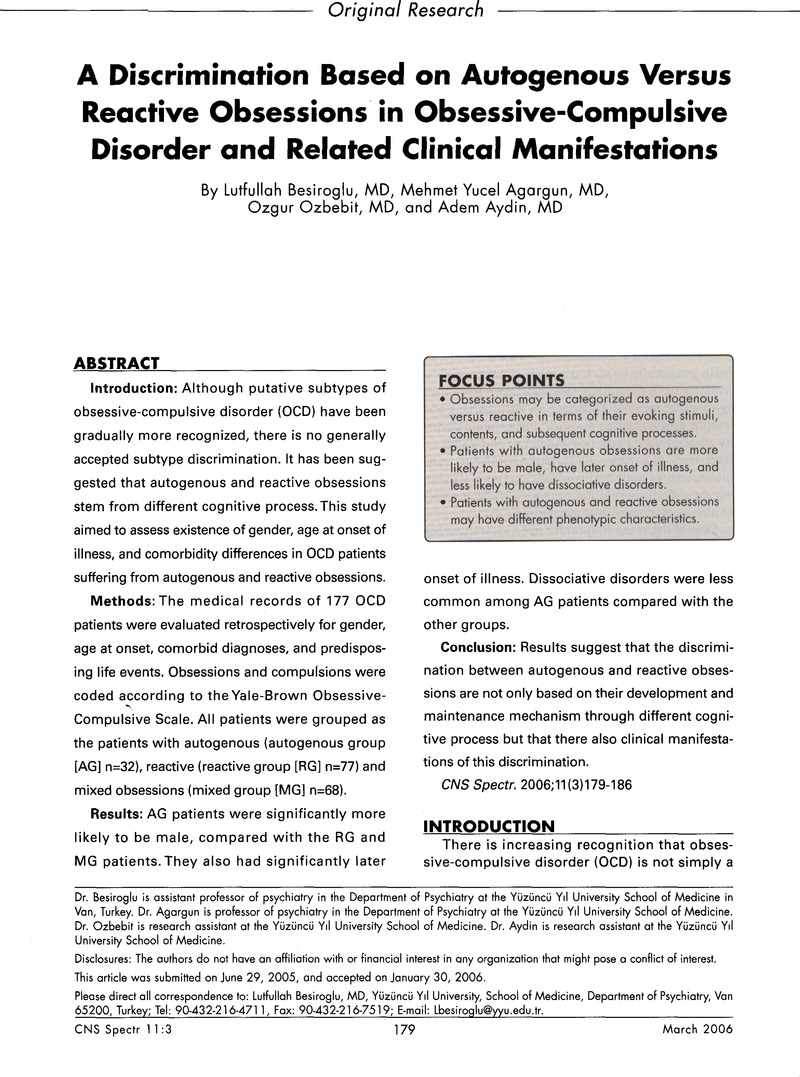Crossref Citations
This article has been cited by the following publications. This list is generated based on data provided by Crossref.
Besiroglu, L.
Sozen, M.
Ozbebit, Ö.
Avcu, S.
Selvi, Y.
Bora, A.
Atli, A.
Unal, O.
and
Bulut, M. D.
2011.
The involvement of distinct neural systems in patients with obsessive–compulsive disorder with autogenous and reactive obsessions.
Acta Psychiatrica Scandinavica,
Vol. 124,
Issue. 2,
p.
141.
Selvi, Yavuz
Besiroglu, Lutfullah
Aydin, Adem
Gulec, Mustafa
Atli, Abdullah
Boysan, Murat
and
Celik, Cihat
2012.
Relations between childhood traumatic experiences, dissociation, and cognitive models in obsessive compulsive disorder.
International Journal of Psychiatry in Clinical Practice,
Vol. 16,
Issue. 1,
p.
53.
Subirà, Marta
Alonso, Pino
Segalàs, Cinto
Real, Eva
López-Solà, Clara
Pujol, Jesús
Martínez-Zalacaín, Ignacio
Harrison, Ben J.
Menchón, José M.
Cardoner, Narcís
Soriano-Mas, Carles
and
Harel, Noam
2013.
Brain Structural Alterations in Obsessive-Compulsive Disorder Patients with Autogenous and Reactive Obsessions.
PLoS ONE,
Vol. 8,
Issue. 9,
p.
e75273.
Abramowitz, Jonathan S.
Fabricant, Laura E.
Taylor, Steven
Deacon, Brett J.
McKay, Dean
and
Storch, Eric A.
2014.
The relevance of analogue studies for understanding obsessions and compulsions.
Clinical Psychology Review,
Vol. 34,
Issue. 3,
p.
206.
Rowsell, Marsha
and
Francis, Sarah E.
2015.
OCD subtypes: Which, if any, are valid?.
Clinical Psychology: Science and Practice,
Vol. 22,
Issue. 4,
p.
414.
Batmaz, Sedat
Yildiz, Mesut
and
Songur, Emrah
2016.
Psychopharmacological treatment differences in autogenous and reactive obsessions: A retrospective chart review.
Nordic Journal of Psychiatry,
Vol. 70,
Issue. 1,
p.
31.
Del Casale, Antonio
Sorice, Serena
Padovano, Alessio
Simmaco, Maurizio
Ferracuti, Stefano
Lamis, Dorian A.
Rapinesi, Chiara
Sani, Gabriele
Girardi, Paolo
Kotzalidis, Georgios D.
and
Pompili, Maurizio
2019.
Psychopharmacological Treatment of Obsessive-Compulsive Disorder (OCD).
Current Neuropharmacology,
Vol. 17,
Issue. 8,
p.
710.
Xia, Jie
Fan, Jie
Liu, Wanting
Du, Hongyu
Zhu, Jiang
Yi, Jinyao
Tan, Changlian
and
Zhu, Xiongzhao
2020.
Functional connectivity within the salience network differentiates autogenous- from reactive-type obsessive-compulsive disorder.
Progress in Neuro-Psychopharmacology and Biological Psychiatry,
Vol. 98,
Issue. ,
p.
109813.
Berman, Noah Chase
Hayaki, Jumi
and
Szkutak, Abigail
2020.
Emotion generation and regulation following an intrusion induction: Implications for taboo or autogenous obsessions.
Journal of Behavior Therapy and Experimental Psychiatry,
Vol. 69,
Issue. ,
p.
101593.
Danışman Sonkurt, Melis
Altınöz, Ali E.
Köşger, Ferdi
Yiğitaslan, Semra
Güleç, Gülcan
and
Eşsizoğlu, Altan
2022.
Are there differences in oxidative stress and inflammatory processes between the autogenous and reactive subtypes of obsessive-compulsive disorder? A controlled cross-sectional study.
Brazilian Journal of Psychiatry,
Vol. 44,
Issue. 2,
p.
171.
Fan, Jie
Xia, Jie
Liu, Qian
Wang, Xiang
Du, Hongyu
Gao, Feng
Han, Yan
Yu, Quanhao
Lu, Jingjie
Xiao, Chuman
Tan, Changlian
and
Zhu, Xiongzhao
2023.
Neural substrates for dissociation of cognition inhibition in autogenous- and reactive-type obsessive-compulsive disorder.
Journal of Psychiatric Research,
Vol. 165,
Issue. ,
p.
150.



